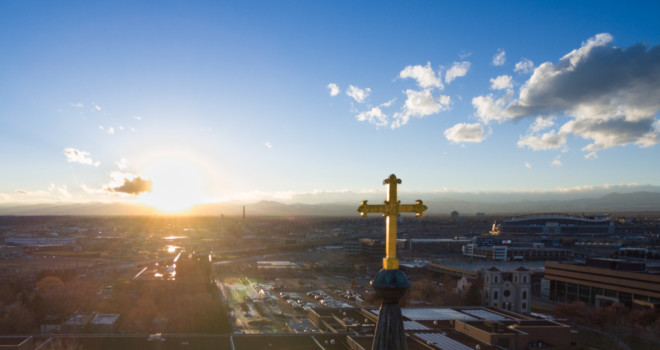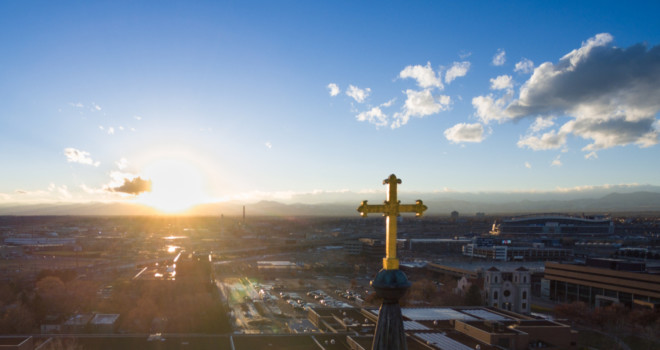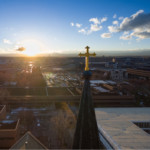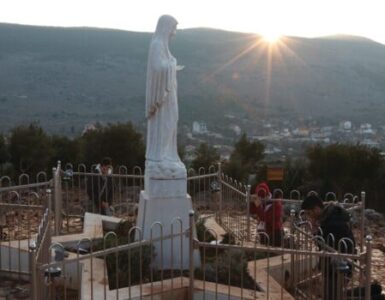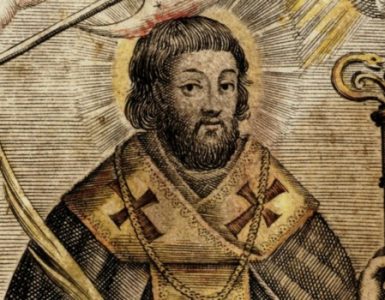Our Catholic faith teaches us, “Pilgrimages evoke our earthly journey toward heaven and are traditionally very special occasions for renewal in prayer” (CCC 2691). Pilgrimages are vital to our faith. In the foothills of the Rocky Mountains, Denver, Colorado, offers a delightful pilgrimage, which might not be expected by a traveler at first thought. Yet, with a bit of Catholic imagination and some good planning, Denver is a fantastic location in which pilgrims can encounter the glory of the Lord and grow in faith.
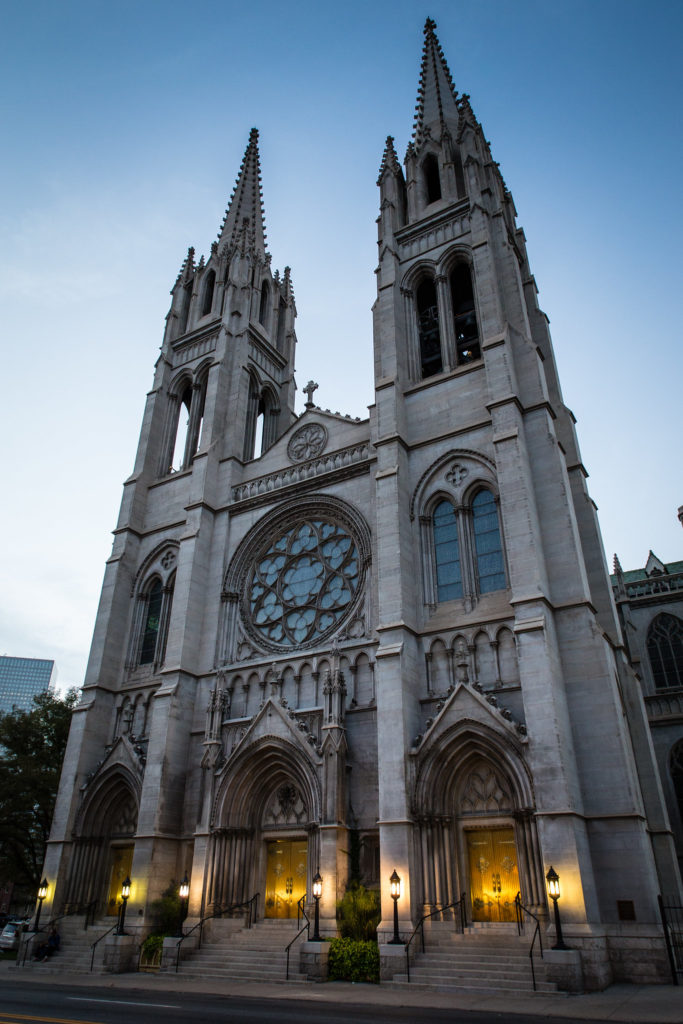
Any great pilgrimage focuses on the Eucharist, and great cities often have great cathedrals. Denver’s cathedral, downtown on Logan Street, is the Cathedral Basilica of the Immaculate Conception, which is a special place to worship. After Mass, it is a great blessing to hang around and see some other special things in the basilica (proclaimed such by St. John Paul the Great upon his visit in 1993). This cathedral contains a collection of stained-glass windows that is second-to-none in the western hemisphere. From about ten-feet high, every wall of the Roman Gothic structure is covered with beautiful depictions of the mysteries of Jesus’ life, the life of Mary, and images of well-known biblical figures and saints. One could stand and ponder these windows for hours without looking at the same image twice.
In addition to its fantastic collection of stained-glass windows, the cathedral houses the tomb of Servant of God Julia Greeley. Greeley was a woman of African descent born into slavery in Hannibal, Missouri, sometime in the 1830s or 1840s. After her emancipation at the end of the American Civil War, she remained for a short while in Missouri. Then she moved westward, living and working (usually as a domestic servant) at places such as Cimarron, New Mexico, Laramie and Cheyenne, Wyoming, and, of course, Denver, Colorado. During her years in Denver, she also took vows as a Secular Franciscan. Praying at the tomb of Julia Greeley was one of the very special moments on pilgrimage. In our age of heightened racial tension in the United States, Greeley can be a great intercessor for the peace that we all desire.
The cathedral is not the only place in Denver with great art. The Denver Art Museum is seven floors of an overwhelming collection of art from a broad range of historical cultural settings. To take in all that this museum has to offer, I would recommend multiple visits, or visiting on a day when it closes later in the evening. The museum houses the Casentenio Altarpiece and Vincenzo Scamozzi’s travel journal from the early modern period. It also houses Childhood Idyll by the iconic Bouguereau, which is one of the great highlights of the whole museum. There are a couple of Degas paintings, typically focused on young ladies dancing. There are many, many other wonderful pieces of painted art, photography, and historical clothing that are sure to tantalize the eyes and intellect of visitors.
The same Catechism paragraph quoted above goes on: “For pilgrims seeking living water, shrines are special places for living the forms of Christian prayer ‘in Church.’” On another day of the pilgrimage, it is a great spiritual gift to visit the Mother Cabrini in Golden, Colorado. This shrine is a special place of prayer, and even a place to find miraculous water. The pinnacle of the shrine is a statue of the Sacred Heart of Jesus, which resides at the top of nearly 400 stairs. These moments at the top of the shrine on the mountain bring us amazingly close to the Lord. After I climbed the stairs with snow falling around me, and as I looked out into the snow-capped Rockies, a prayer came into my mind and heart: “After my arduous pilgrimage up the proverbial steps of this life, receive me, O Jesus, into your glory and joy.”
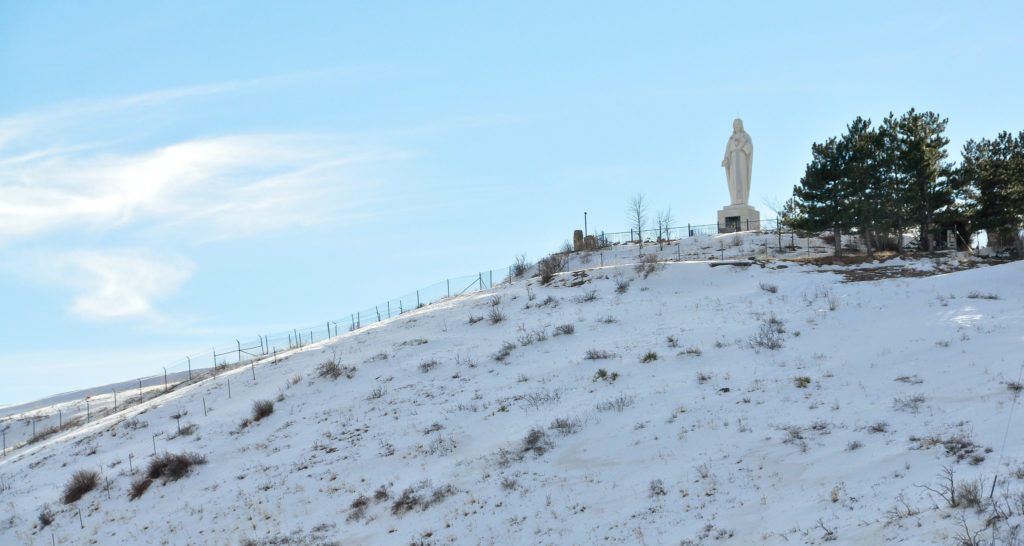
Another special moment at the shrine happens when one tastes the miraculous spring water that has been continuously flowing since the late-nineteenth century. The property was originally thought to only contain stagnant water, but the prayers and diligence of Mother Cabrini and her sisters revealed something else. This also makes a wonderful moment of prayer, asking the Lord, through Cabrini’s intercession, to provide His grace continuously, even when we think it is not possible or likely.
This shrine also has a fantastic little history museum. Occupying Cabrini’s original house on the property, this museum tells the story of her life and mission, along with the history of her community of sisters. It is easy to spend an hour or more in the tiny one-room museum, and to come away with a much deeper appreciation for Cabrini’s impact on the region and the immigrant history of the United States.
If time allows, two other sites are well worth adding to the pilgrimage itinerary. First, there is Cherry Creek State Park, which was the site of closing Mass of World Youth Day 1993. This event was incredibly special for many Catholics in the United States and North America. A quick poll of Catholics between the ages of 45 and 60 will likely reveal that many of them attended, and most of them at least remember, the first Catholic event of its kind in the United States.
Denver is also home to the Orthodox Cathedral of the Assumption of the Theotokos. The icon murals at the cathedral are simply breathtaking, and they lead a pilgrim far deeper into prayer. If one happens to be in town on a Sunday morning, she should visit the Orthros (“daybreak”) prayer service, which gives her the true taste of the spirituality of Eastern Christians. It is similar to the Liturgy of the Hours, in some ways, beginning with Psalms and including petitions along with other hymns. Taking in such a church and Byzantine prayer service allows a pilgrim to experience the Eastern Church along with the typical Roman Rite, to experience the Church breathing with both her lungs, as St. John Paul II would say.
So, I encourage anyone to make a pilgrimage to Denver. There is more to lift us up in faith than we might originally expect. Such a pilgrimage has the potential to lift our faith to heights at least as high as the city itself, and even beyond.
✠


